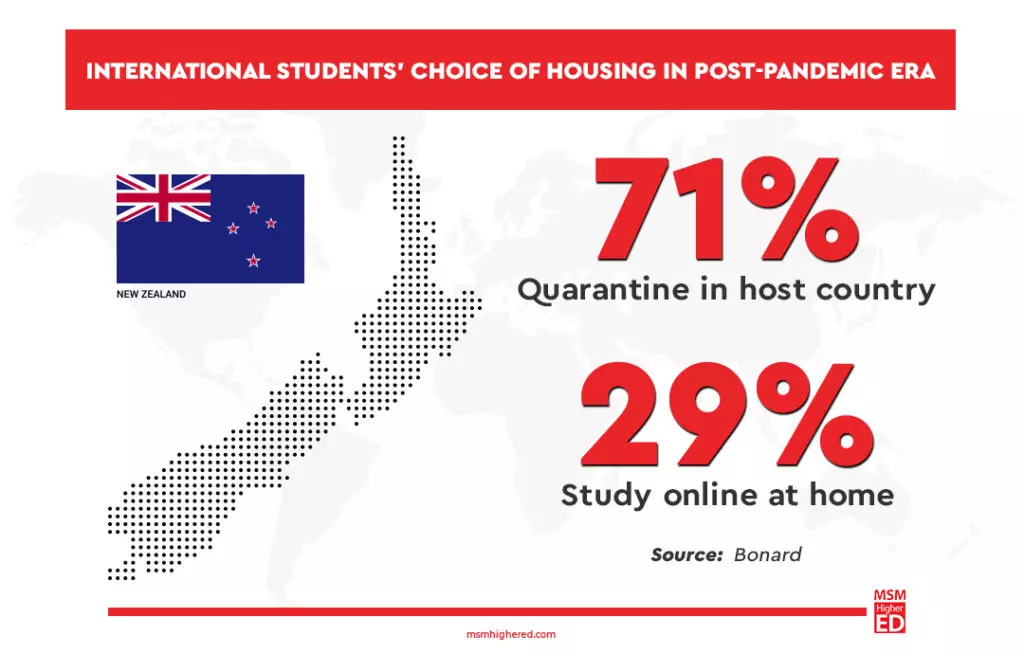While the international education agency of New Zealand believes it may take up to 10 years before the country’s $4.9 billion international education sector is up to speed, it is optimistic that it will not only revert to what it once was but will rebound even better by leaps and bounds.
Key Points at a Glance
- New Zealand’s international education sector contributes $4.9 billion annually with its 120,000 international students pre-COVID.
- New Zealand leadership sees country’s borders remaining closed in 2021
- The New Zealand government approved a Strategic Recovery Plan for International Education in July 2020 with a $51.6 million budget.
- Several initiatives and updates surrounding international education in New Zealand have been set forth, including a landmark pathways partnership.
- However, 79 percent of international students would rather “quarantine” abroad than study online at home.
- New Zealand education providers risk losing international students to Australia and Canada if borders do not open sooner.
Education New Zealand (ENZ) chairman Steve Maharey spoke before the Parliament’s Education and Workforce Select Committee, and said that by 2030, the sector will be “very different, very positive.”
Before COVID-19, there were an estimated 120,000 international students in New Zealand. When the pandemic hit, international students returned to their homes and the country closed its borders due to the strict health and travel restrictions. New Zealand first announced it was temporarily suspending applications for temporary visas from outside New Zealand on Aug. 10, 2020, and then extending it to Feb. 28, 2021.
As of July 2021, its borders remain closed to everyone but New Zealand citizens and residents. Minister of Education Chris Hipkins has said in past interviews that he sees the country imposing the same border restrictions in the next “12-18 months.”
In July 2020, the New Zealand government outlined its Strategic Recovery Plan for International Education. It also approved $51.6 million for its budget. Its framework highlights three concurrent workstreams: create sector stability, strengthen the international education system, and transform the country’s international education approach for a more innovative, robust, and sustainable future.
In less than a year, New Zealand is busy taking concrete steps to rebuild its international education sector.
In December 2020, ENZ and New Zealand’s eight universities announced a partnership with University Consortium (NCUK), enabling students in more than 30 countries to start their New Zealand university qualification while at home. Such partnership is a first for New Zealand.
In January, the country approved an “exception class” for 1,000 international students who were almost done with their studies.
In April, ENZ sent out an invitation to organizations to host international education centers in the country, which would be expected to operate by 2022. This is in line with the ENZ’s New Zealand Global Education Pathways announced December 2020.
In June 14 to 18, ENZ hosted the New Zealand Partners Workshop Week attracting more than 45 international speakers, across 234 sessions, with partners were Asian government stakeholders, education institutes, agents and media from China, India, Indonesia, Japan, Korea, Malaysia, Singapore, the Philippines, Thailand, and Vietnam.
Asia is crucial to New Zealand’s international education sector, with 90,000 students from Asia coming to New Zealand in 2019.
In May, the government announced it would provide up to 400 spaces in Managed Isolation and Quarantine for international students set to arrive in June.
COVID-19 healthcare for international students in New Zealand is active as well with free testing and vaccine eligibility, although Universities New Zealand estimates only about 10,000 international students to return to universities.

In all of this good news, however, a greater challenge remains. New Zealand may provide all the solutions to their problems, but are international students seeing these as the same answers to their own preferences?
According to research results by Austria-based international education and student housing data provider Bonard in May, 71 percent of students would rather quarantine in a host country than study online at home (29 percent). At the end of the day, study abroad is tied up to the cultural, travel experience as it is to the quality of education.
New Zealand’s borders might stay closed for the rest of 2021, and while the few examples cited above give international students a peek of how the country is welcoming them with open arms—even from miles away, the country’s education providers remain in their plea for borders and visa processing to open sooner than later as they all risk losing international students to Australia and Canada.















































